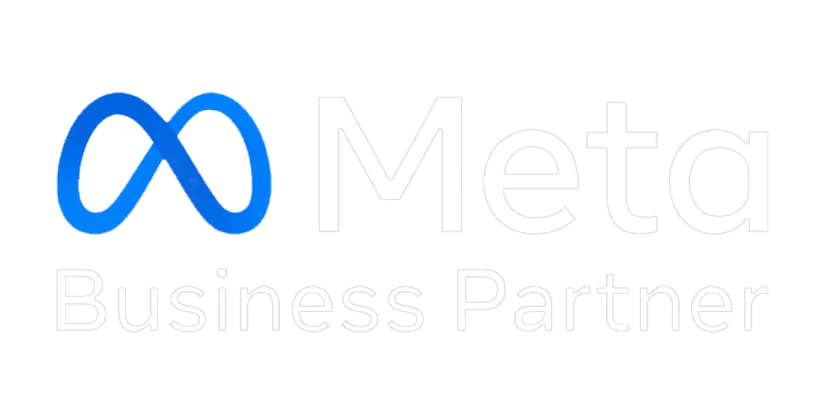Winning the Digital Shelf: Growth Strategies for D2C Brands

In the crowded online landscape, your D2C (direct-to-consumer) brand must do more than just exist — it needs to own the shelf wherever your customers shop and browse. Winning the digital shelf means delivering at every touchpoint: your website, social channels, marketplaces, mobile apps, and even offline activations. Here’s how forward-thinking D2C brands can elevate their game in 2025 and beyond. 1. Build Product Pages That Convert Your product page is often the final mile before conversion. Nail it, and you increase revenue. Mess it up, and a customer leaves. High-quality visuals and video Clear, benefit-first copy Social proof & validation Technical performance & on‑page foundations 2. Strategically Expand Across Channels You don’t have to be everywhere — be effective where your audience lives. Marketplaces for reach, not margin Social & live commerce Offline and experiential touchpoints 3. Personalization & Smart Customer Journeys Your customers crave unique experiences. Generic no longer works. Hyper‑personalization Loyalty, subscriptions & referral programs 4. Data, Analytics & Optimization Data should drive your decisions — not gut feel. Digital shelf health & visibility tracking Pricing & inventory intelligence Experimentation & lift measurement 5. Fuel Growth with Marketing & Acquisition No matter how perfect your shelf is, you still need traffic and reach. High-intent paid channels Content & brand storytelling Influencers, partnerships & community-driven traction Email & SMS sequencing 6. Brand Trust & Signals You must earn trust at every step. Conclusion “Winning the digital shelf” isn’t a one-time task — it’s an ongoing process. It means optimizing your product experience, channel strategy, personalization, marketing, and operations — all in lockstep with real-time data and customer feedback. As a D2C brand, your greatest advantage is direct access to your customer — use it wisely. Audit your presence today (including content from TheBotMode for digital growth), uncover your biggest gaps, and start iterating deliberately. FAQs Q: What is the digital shelf? A: It’s where your products appear online—your site, marketplaces, and social media. Q: How many marketplaces should I be on? A: Start with 1–2 that align with your audience; expand gradually. Q: Is personalization really effective? A: Yes—personalized experiences increase sales and retention. Q: What metrics matter most? A: Focus on AOV, CLTV, conversion rate, and product visibility. Q: How can I avoid pricing conflicts across channels? A: Use dynamic pricing, channel rules, and monitor for overlap.
Top 5 WhatsApp Chatbot Automation Providers in 2025

In 2025, WhatsApp automation has become a must-have for businesses of every size. From abandoned cart recovery to customer support and lead nurturing — a good WhatsApp chatbot provider can automate it all.But with dozens of options in the market, which platform should you choose? Let’s break down the top 5 WhatsApp chatbot automation providers in 2025 based on reliability, pricing, AI capability, and use cases. 1. TheBotMode – AI-Driven WhatsApp Commerce Platform Website: thebotmode.comBest for: D2C brands, Shopify & WooCommerce stores Why It Stands Out:TheBotMode is an AI-powered WhatsApp automation suite designed for eCommerce and D2C brands. It helps businesses recover abandoned carts, verify COD orders, reduce RTO, and even send personalized product recommendations. Key Features: Ideal Use Case: If you want a single tool to manage marketing, support, and order updates via WhatsApp — TheBotMode offers the perfect balance of automation and intelligence. 2. Interakt – Simple and Reliable WhatsApp CRM Website: interakt.shopBest for: SMBs and WhatsApp-first customer support Why It Stands Out:Interakt (from Jio Haptik) focuses on helping small and medium businesses centralize customer conversations and manage sales on WhatsApp. Key Features: Ideal Use Case:Best suited for small businesses that need a reliable, budget-friendly solution for WhatsApp marketing and basic chat automation. 3. WATI – CRM + No-Code Flow Builder Website: wati.ioBest for: Customer support teams & lead generation Why It Stands Out:WATI offers a visual chatbot builder and team collaboration tools. It’s great for scaling support operations and marketing automation with minimal tech skills. Key Features: Ideal Use Case:Perfect for teams that want to automate FAQs and handle large volumes of support chats efficiently. 4. AiSensy – Powerful Marketing Automation for WhatsApp Website: aisensy.comBest for: Campaign automation & analytics-driven brands Why It Stands Out:AiSensy focuses on marketing automation with an easy UI and quick template approval. It helps brands broadcast thousands of messages with analytics tracking. Key Features: Ideal Use Case:If your goal is to run high-volume WhatsApp campaigns with ease, AiSensy is one of the most accessible platforms. 5. Zoko – WhatsApp-First Revenue Platform Website: zoko.ioBest for: WhatsApp-based sales & multi-agent support Why It Stands Out:Zoko turns WhatsApp into a complete sales, marketing, and support hub. It’s popular among growing D2C brands for managing storefronts directly inside WhatsApp. Key Features: Ideal Use Case:Best for brands that use WhatsApp as their main commerce channel and want a centralized dashboard to manage sales. Comparison Table Provider Key Strength Best For Shopify/WooCommerce Integration Pricing Range TheBotMode AI-powered automation, eCommerce-focused D2C & retail brands ✅ Yes ₹2,500–₹8,000/month Interakt CRM & customer chat SMBs ✅ Yes From ₹999/month WATI Visual chatbot builder Customer support ✅ Yes From $30/user/month AiSensy Campaign automation & analytics Marketers ✅ Yes From ₹999/month Zoko WhatsApp-first storefront Mid to large D2C ✅ Yes From $34/month Final Verdict Each platform has its own strengths, but if you’re an eCommerce or D2C brand, TheBotMode stands out for its AI-driven flows, real-time Shopify sync, and COD order automation — something other platforms still struggle to achieve. If you’re looking for simple CRM-based WhatsApp management, Interakt or WATI might suit better. For marketing automation, AiSensy and Zoko are great picks. FAQs Q1: What is a WhatsApp chatbot automation platform? A WhatsApp chatbot automation platform helps businesses send automated messages, handle FAQs, manage customer chats, and run campaigns using the official WhatsApp Business API. Q2: Which is the best WhatsApp chatbot for eCommerce brands? For eCommerce, TheBotMode offers the best features like abandoned cart recovery, COD verification, and personalized order updates. Q3: Can I use these tools without coding? Yes. Most of these providers — including WATI, AiSensy, and TheBotMode — offer no-code or low-code builders for flow creation. Q4: Which provider gives AI-based message scheduling? TheBotMode uses AI to analyze message read times and auto-schedule campaigns for maximum engagement. Q5: Is WhatsApp automation allowed by Meta? Yes, all the above providers use the official WhatsApp Business API, fully approved and compliant with Meta’s policies. Conclusion Choosing the right WhatsApp chatbot provider in 2025 depends on your business goals — whether it’s automation, customer service, or marketing at scale.If you want AI-powered commerce automation, go for TheBotMode.If you want marketing-first bulk campaigns, try AiSensy or Zoko.And for support-centric CRMs, WATI or Interakt will work best.
From Startup to Scale-Up: How to Grow Your WhatsApp Marketing Limit Without Losing Quality
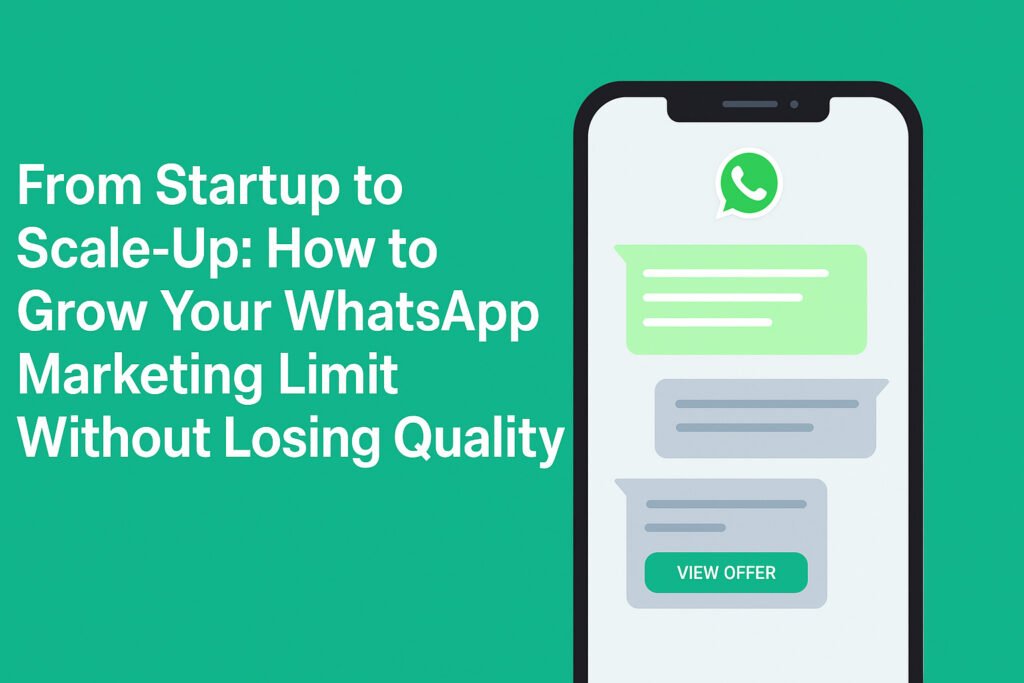
Introduction Scaling a startup is exciting — but when it comes to WhatsApp marketing, growth brings its own set of challenges. Every D2C brand dreams of sending thousands of personalized messages, but hitting WhatsApp’s daily message limits too early can slow you down. So, how do you grow your WhatsApp marketing limit from 250 to 100,000+ without hurting your message quality or risking bans? In this guide, we’ll show you exactly how to increase your WhatsApp Business API limit step-by-step while maintaining top-tier engagement and reputation. 1. Understand WhatsApp Messaging Limits WhatsApp sets conversation limits to protect users from spam. Every verified business starts small and can gradually unlock higher tiers based on quality, engagement, and volume usage. Tier Limit (24 Hours) Requirement Tier 0 250 unique users Default for new numbers Tier 1 1,000 users After business verification Tier 2 10,000 users Consistent quality and engagement Tier 3 100,000 users Excellent reputation and message quality Tier 4+ Unlimited Enterprise-level quality and usage Your WhatsApp quality rating — measured as High (Green), Medium (Yellow), or Low (Red) — determines how fast you can scale. Maintaining a High rating is the key to unlocking higher tiers automatically. 2. The Smart Path to Grow Your WhatsApp Limit Growing your messaging limit doesn’t happen overnight. It’s a gradual process driven by trust, relevance, and engagement. Step 1: Verify and Optimize Early Step 2: Start with Quality, Not Quantity Step 3: Keep Message Quality High Step 4: Monitor & Improve Engagement WhatsApp automatically promotes your business to higher tiers if you maintain a healthy delivery rate and low block/report ratio. Step 5: Scale in Phases Once you hit 70–80% of your current tier capacity with good quality: 3. Best Practices to Maintain Message Quality Even as you scale to 100K+ messages, quality > quantity should remain your mantra. Get explicit opt-ins: Never message users without consent.Segment smartly: Send different messages to new vs returning buyers.Respect frequency: Limit to 1–2 marketing messages per user per day.Provide easy opt-out: A simple “Stop” or “Unsubscribe” keeps trust intact.Test before sending: Always preview templates for tone, spacing, and personalization.Use analytics: Platforms like TheBotMode offer click, read, and response tracking to optimize campaigns. 4. How TheBotMode Helps You Scale Smarter At TheBotMode, we make scaling your WhatsApp marketing effortless and compliant: With TheBotMode, your growth from 1,000 to 100,000 messages happens smoothly — without risking your WhatsApp reputation. 5. Common Mistakes That Hurt Growth Sending to unverified or cold numbersReusing old templates repeatedlySending purely promotional messagesIgnoring quality alerts from MetaSending too many messages at once Avoid these, and you’ll see your tier upgrade happen naturally within weeks. 6. Quick Timeline to Scale Up Phase Duration Expected Growth Key Tip Startup Week 1–2 250 → 1,000 Build trust with verified opt-ins Growth Week 3–6 1,000 → 10,000 Improve engagement metrics Scale-Up Month 2–3 10,000 → 100,000 Automate campaigns, monitor quality 7. FAQs Q1: How can I increase my WhatsApp Business API limit quickly? Keep your quality rating high, use verified templates, and gradually expand campaign volume. Q2: What happens if my quality rating drops? WhatsApp may reduce your limit or temporarily pause outbound messaging. Q3: How does TheBotMode help with scaling? TheBotMode provides analytics, automation, and compliance tools that ensure your campaigns stay optimized and high-quality as you scale. Conclusion Growing your WhatsApp marketing limit isn’t about sending more messages — it’s about sending better messages.With the right mix of compliance, personalization, and smart automation, your brand can move from startup to scale-up effortlessly. TheBotMode empowers D2C brands to scale their WhatsApp campaigns from a few hundred to over 100K+ customers per day — all while keeping quality, engagement, and ROI intact.
Improve Post-Purchase Experience with Order Notifications
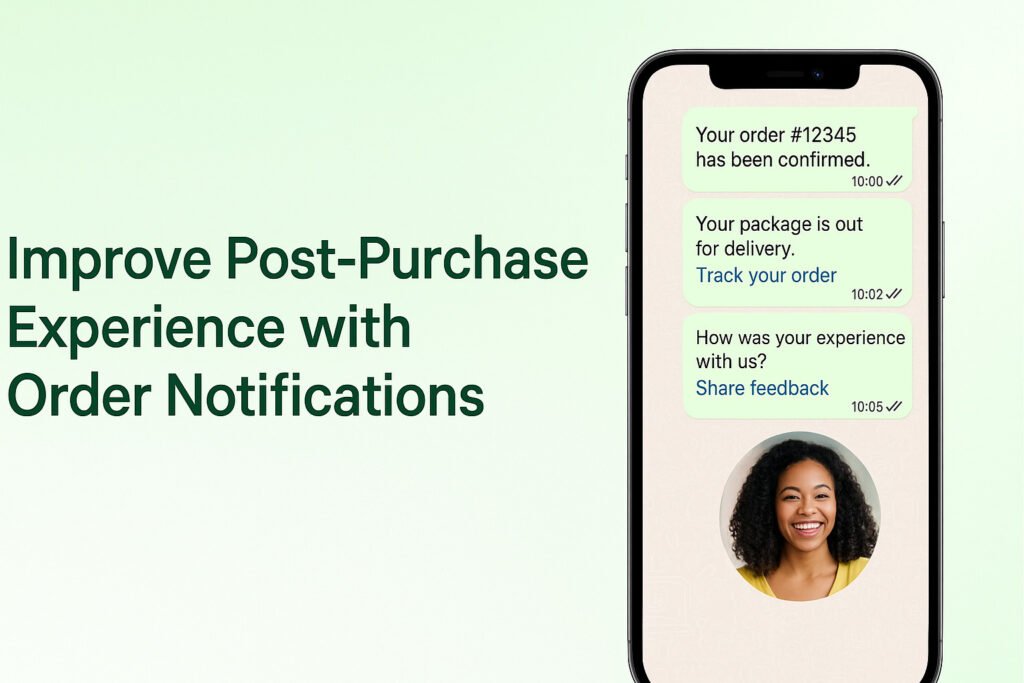
1. The Power of the Post-Purchase Experience For any eCommerce or D2C brand, the journey does not end when a customer clicks “Buy Now.”The true brand experience begins after purchase. The period between order confirmation and delivery determines how customers perceive reliability, trust, and service quality. Most customer dissatisfaction happens not because of bad products but because of poor communication after checkout. Keeping customers informed through automated order updates can completely transform this experience. 2. What Are WhatsApp Order Notifications? WhatsApp order notifications are automated messages sent to customers through the official WhatsApp Business API. These updates keep customers informed at every stage of their purchase journey. Common examples include: Unlike emails or SMS, WhatsApp ensures almost-instant visibility. With open rates exceeding 98%, it is the most effective channel for order communication. 3. Why Post-Purchase Communication Matters Customers expect transparency once they have paid. They want to know: Consistent communication reduces anxiety, minimizes support tickets, and builds long-term loyalty.A satisfied customer often becomes a repeat buyer and brand advocate. 4. How The BotMode Enhances Post-Purchase Journeys The BotMode helps D2C brands automate every stage of post-purchase communication through WhatsApp. The setup is quick, compliant, and directly integrated with platforms like Shopify and WooCommerce. a. Real-Time Order Updates Send automated confirmations, shipping alerts, and delivery notifications instantly without manual work. b. COD Verification and RTO Reduction For Cash-on-Delivery orders, verify customer intent via WhatsApp to reduce return-to-origin (RTO) losses. c. Clickable Tracking Links Add direct tracking URLs within messages so customers can check delivery status instantly. d. Automated Feedback and Review Requests Gather post-delivery feedback to improve service quality and collect social proof automatically. e. Upsell and Cross-Sell Opportunities After delivery, follow up with personalized product recommendations or loyalty offers to encourage repurchase. 5. WhatsApp vs Email vs SMS Channel Average Open Rate Response Rate Engagement Style Email 15–25% 2–5% Delayed, often ignored SMS 70% 10% One-way, impersonal WhatsApp 98%+ 45%+ Conversational, trusted, real-time This data shows why modern D2C brands choose WhatsApp for mission-critical order communication. 6. Results from Brands Using The BotMode Brands using The BotMode’s WhatsApp automation have reported: Automated order notifications help brands retain customers and reduce operational overhead at the same time. 7. How to Get Started 8. The Future of Post-Purchase Experience As consumer expectations rise, instant and transparent updates are becoming the new norm.By using The BotMode’s WhatsApp automation, brands can create memorable experiences that continue beyond the sale. Every order notification becomes an opportunity to strengthen relationships, build trust, and drive repeat purchases. A great customer journey doesn’t end at checkout — it continues through communication. Frequently Asked Questions Q1: Are WhatsApp order notifications Meta-approved? Yes. All message templates used for order updates are reviewed and approved by Meta to ensure compliance. Q2: Can The BotMode integrate with Shopify or WooCommerce? Yes. The BotMode offers seamless integration with both platforms for instant automation. Q3: Can I include tracking links inside WhatsApp messages? Yes. You can embed clickable tracking links that lead customers directly to courier tracking pages. Q4: What are the costs involved? WhatsApp messages are billed per conversation, and The BotMode offers transparent pricing based on Meta’s official API rates. Q5: Can I collect reviews automatically? Yes. The BotMode can trigger automated review or feedback messages after order delivery.
How D2C Brands Can Use WhatsApp Business to Boost Sales & Loyalty
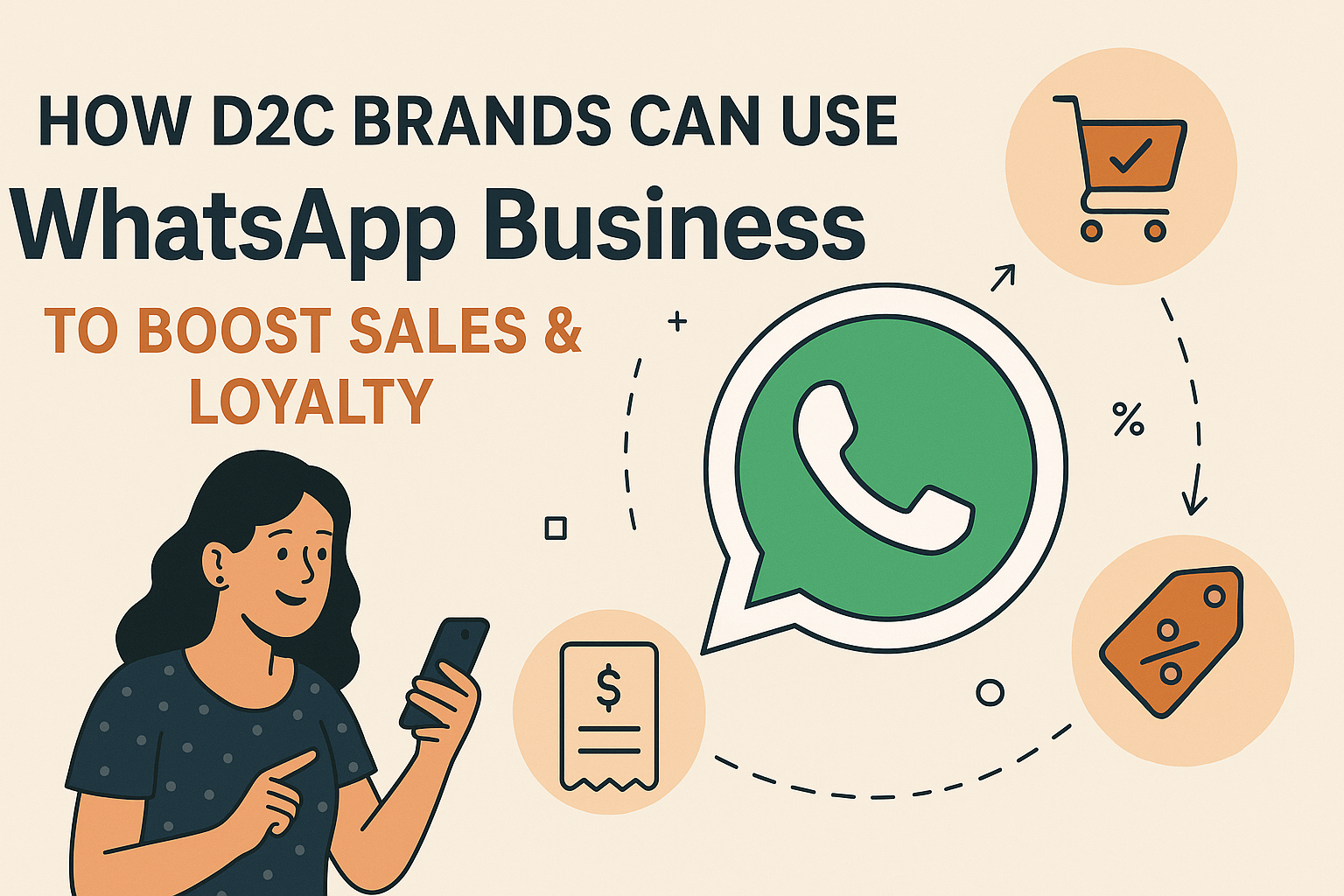
Introduction In the world of D2C (Direct-to-Consumer), customer relationships are everything. While paid ads get attention, it’s conversations that convert. WhatsApp Business is emerging as the most powerful tool in the D2C arsenal—offering a direct, personal, and scalable way to drive both sales and loyalty. If you’re a D2C brand wondering how to tap into WhatsApp Business to increase revenue and retain happy customers, this blog is your blueprint. Why WhatsApp Business Is Crucial for D2C Brands WhatsApp is not just a messaging app—it’s where over 2 billion users communicate daily. For D2C brands, it offers: Simply put, WhatsApp gives D2C brands the power to talk like a friend, sell like a brand. Setting Up WhatsApp Business for D2C Success Step 1: Choose the Right Version Step 2: Get Verified Step 3: Create a Product Catalog Step 4: Integrate Tech Stack Strategies to Drive Sales with WhatsApp Business 1. Abandoned Cart Recovery Remind customers about items left behind. Add urgency (“Only 3 left!”) and media-rich previews. 2. Click-to-WhatsApp Ads Run Instagram/Facebook ads that open a chat instead of a landing page. Use it to close high-intent leads in real-time. 3. Product Discovery via Catalog Let shoppers browse and buy right from the chat—frictionless, fast, and mobile-friendly. 4. Personalized Upsell & Cross-Sell Recommend complementary items post-purchase or suggest upgrades with personalized messaging. 5. Flash Sales & WhatsApp-Only Deals Make your WhatsApp audience feel exclusive with early access to new launches or VIP discounts. Strategies to Build Customer Loyalty with WhatsApp Business 1. Post-Purchase Automation Send instant confirmations, shipping updates, and “Thank You” messages to build trust. 2. Easy Customer Support Automate FAQs, returns, and warranty queries while routing complex cases to human agents. 3. Loyalty Points & Rewards Inform customers about loyalty points, send reminders to redeem, and share progress updates. 4. Personalized Reorder Reminders Use purchase history to trigger messages like:“Running low on your favorite shampoo? Reorder now with 10% off.” 5. Educational & Engaging Content Share skincare routines, recipe ideas, style guides, or UGC to keep your brand top-of-mind. Automation, Tools & Best Practices Key Metrics to Measure Success Common Challenges & How to Overcome Them Challenge Solution Spam complaints Use opt-ins & clear unsubscribe options Template delays Pre-approve promotional and transactional templates in advance High chat volumes Combine chatbots + live agents Compliance issues Stick to opt-in policies, data privacy laws Conclusion WhatsApp Business isn’t just another channel—it’s the future of D2C growth. From abandoned cart recovery to loyalty programs, it offers personalized, scalable solutions that delight customers and drive revenue. If you’re ready to transform casual browsers into loyal buyers, it’s time to integrate WhatsApp Business into your D2C marketing playbook. 🔗 Explore automation tools and integrations at TheBotMode.com FAQs Q1: Can I integrate WhatsApp Business with my Shopify store? Yes, using WhatsApp Business API and third-party tools, you can fully integrate it for notifications, carts, and support. Q2: Is WhatsApp Business good for small D2C brands? Absolutely. The WhatsApp Business App is free and perfect for small teams managing customer chats and promotions. Q3: How do I collect opt-ins for WhatsApp? Use your website, checkout page, or Facebook Ads to encourage customers to subscribe for updates via WhatsApp.
How to Use WhatsApp Business Catalog to Showcase Your Products Like a Pro
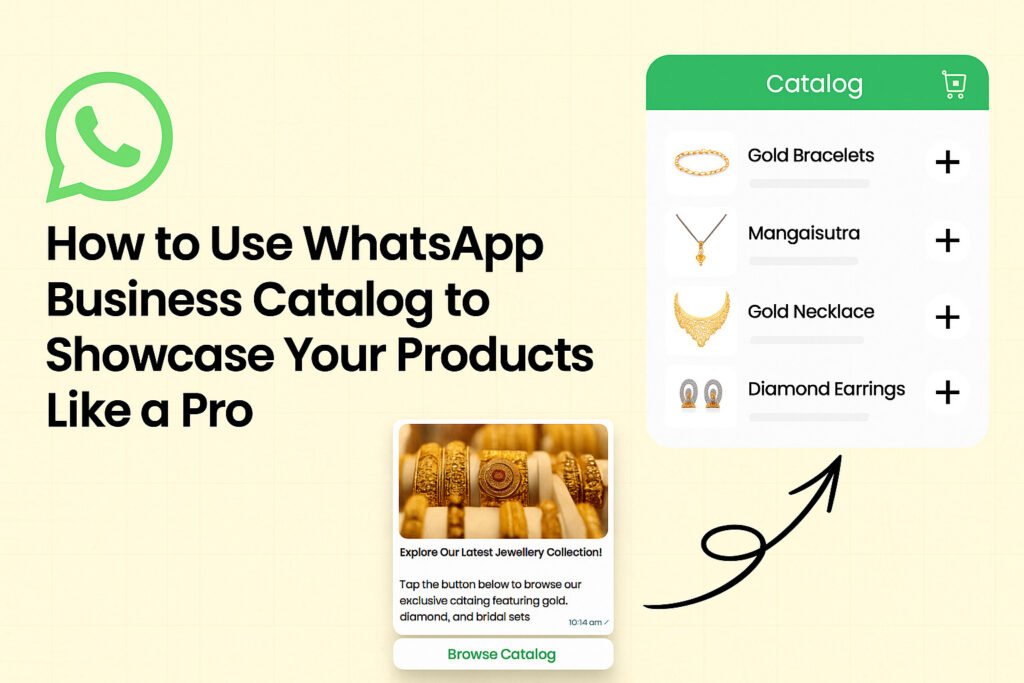
Introduction You’ve built something special — maybe handcrafted jewelry, organic skincare, or trendy apparel — but every time a customer messages you, you end up sending product photos one by one. It’s repetitive, time-consuming, and easy to lose a sale halfway through. Now imagine all your products displayed beautifully inside WhatsApp — browsable, clickable, and synced with your real inventory. That’s what the WhatsApp Business Catalog does. It turns WhatsApp into your digital storefront, helping you showcase products, answer queries, and close orders faster — all from one chat window. This guide by The BotMode shows you how to set it up, optimize it, and combine it with automation tools like WhatsApp Flows, Campaigns, and Click-to-WhatsApp Ads for maximum growth. What is WhatsApp Business Catalog? The WhatsApp Business Catalog is a built-in feature that lets businesses showcase products and services directly inside the app. Each listing can include: Customers can browse your catalog, message you instantly, and even order — without leaving WhatsApp. No website required. It’s perfect for small D2C brands, boutiques, local sellers, and service providers looking to present their offerings in a professional, mobile-first way. Why Every Brand Should Use a WhatsApp Catalog 1. Direct Product Discovery Customers don’t have to ask “What do you sell?” anymore. With your catalog, they can explore your entire range instantly — just like browsing an online shop. 2. Instant Customer Engagement They can tap an item, message you for details, and order — all in one thread. This reduces drop-offs and boosts conversions. 3. Mobile-First Shopping Experience With WhatsApp being the world’s most-used messaging app, bringing your storefront inside the app meets your audience exactly where they are. 4. Professional Look + Verified Trust When paired with a verified business profile (green tick), a clean catalog enhances brand trust and makes your business look established. How to Create a WhatsApp Catalog (Step-by-Step) Step 1: Open WhatsApp Business Use the WhatsApp Business App (for small sellers) or WhatsApp Business API (for scaling with The BotMode). Step 2: Go to Business Tools → Catalog Tap Add Product or Service to start building your catalog. Step 3: Add Product Details Fill in: Step 4: Organize Smartly Group products into collections like: Step 5: Save & Preview Double-check details and publish your catalog. You can add up to 500 items. Pro Tip: Use The BotMode’s WhatsApp Template Automation to instantly reply with phrases like: How to Promote Your WhatsApp Catalog for More Sales 1. Send Catalog via WhatsApp Campaigns Use The BotMode Campaigns to broadcast catalog links to customer segments. Example messages: Personalized catalog sharing improves engagement rates by up to 3x. 2. Run Click-to-WhatsApp Ads From Facebook or Instagram, create ads that lead users straight into your WhatsApp catalog. Example: “Love minimal jewelry? Tap to explore our latest handcrafted pieces.” This creates a frictionless “see-ad → browse → buy” journey. 3. Build Automated Shopping Flows Using The BotMode Flows, guide customers interactively: Hi! 👋 What are you looking for today? 1️⃣ Skincare 2️⃣ Haircare 3️⃣ Body essentials When they choose, send the matching catalog automatically. Smart, fast, and personal. 4. Use WhatsApp Templates for Retargeting Share catalog items inside templates for: 5. Monitor and Update Regularly Out-of-stock items harm credibility. Keep your catalog fresh, update visuals, and track clicks via Meta Business Suite or The BotMode dashboard. Real Business Results Example Strategy Used Outcome Boutique Brand (Mumbai) WhatsApp Catalog + Click-to-WhatsApp Ads +35% weekly orders, -50% queries Skincare Startup Personalized WhatsApp Flows 27% conversion rate Electronics Reseller Catalog-linked templates Instant order confirmations, more repeat buyers Best Practices for a High-Converting Catalog Use high-quality, lightweight imagesKeep product names short and descriptiveAdd persuasive CTAs: Tap to order, Ask size guide, See similar itemsGroup products logicallyRemove outdated or sold-out itemsSync catalog with Shopify or WooCommerce if possible Conclusion In today’s mobile-first world, speed, simplicity, and personalization win sales. The WhatsApp Business Catalog helps you deliver all three — bringing your shop right inside conversations. Pair it with The BotMode’s automation tools — Campaigns, Flows, and Catalog integration — to create powerful, human-like shopping experiences that drive repeat sales and scale your brand effortlessl Start your free trial on TheBotMode.com and launch your WhatsApp-powered catalog today. FAQs Q1. What is a WhatsApp Business Catalog? A digital product listing inside WhatsApp where customers can browse, view details, and message directly to buy. Q2. Is the WhatsApp Catalog free? Yes, it’s free to use. For automation or multi-agent access, use it with the WhatsApp Business API via The BotMode. Q3. How many products can I add? You can upload up to 500 products or services with photos and descriptions. Q4. Can customers buy directly from the catalog? Yes, if payment integrations (like Razorpay or WhatsApp Pay) are connected via API. Q5. Can I manage my catalog using The BotMode? Yes. The BotMode connects your WhatsApp Business API and syncs your catalog, campaigns, and automation in one dashboard.
How Fitness & Wellness Brands Like 2X Nutrition Are Growing Faster with WhatsApp Marketing
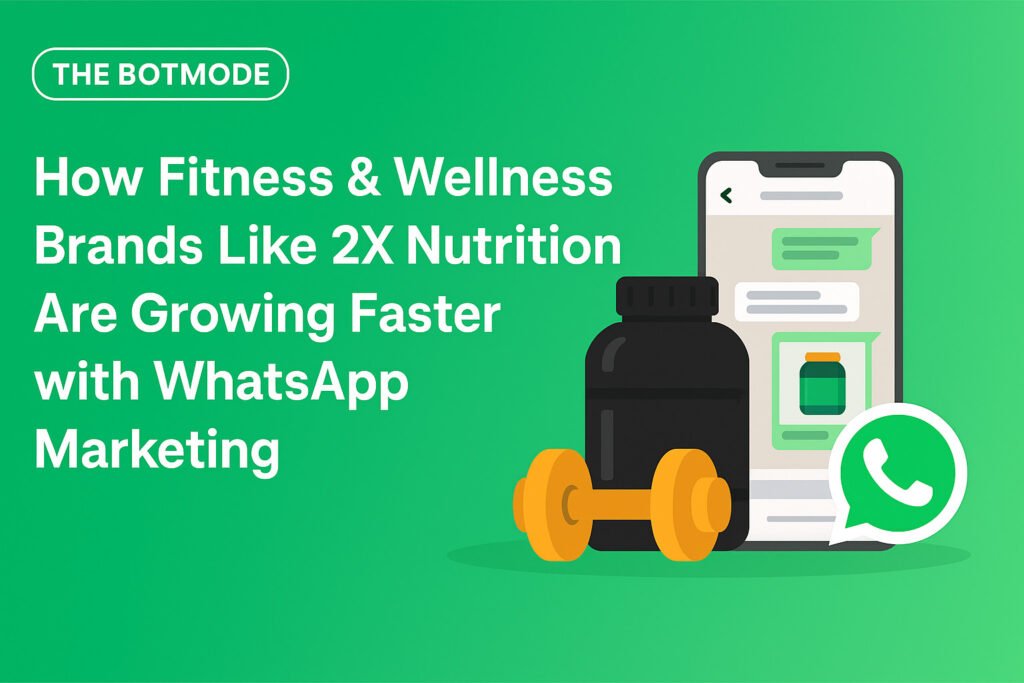
Introduction The fitness and wellness industry has seen massive digital transformation in recent years. Customers are no longer walking into gyms or health stores to make decisions — they’re scrolling, tapping, and chatting online. In this new era, WhatsApp has become the most powerful channel for fitness brands to build real relationships. From promoting supplements to sending personalized workout reminders, brands like 2X Nutrition are using The BotMode’s WhatsApp automation platform to connect with customers in a direct, conversational way — and the results are exceptional. The Fitness Industry Challenge: High Abandonment, Low Engagement Every D2C brand in the wellness space faces a common set of challenges: With health and nutrition products like protein powders, vitamins, or meal replacements, the decision cycle is short — but retention is everything. Brands need to re-engage users fast, with the right message, at the right time. That’s where WhatsApp marketing automation comes in. Why WhatsApp Works Best for Fitness & Wellness Brands How 2X Nutrition Uses The BotMode to Scale with WhatsApp 2X Nutrition, one of India’s fastest-growing fitness brands, sells high-quality supplements, proteins, and vitamins to thousands of athletes and gym-goers. But like most D2C brands, they faced: After integrating The BotMode, they automated the entire customer journey: 1. Cart Recovery Automation When a user adds a product to cart but doesn’t checkout, The BotMode automatically sends a reminder after 30 minutes with a personalized offer — resulting in a 25–30% recovery rate. 2. Subscription & Reorder Reminders The system tracks the average consumption cycle (e.g., protein refills every 30 days) and sends timely WhatsApp reminders — boosting repeat purchase rates significantly. 3. Order Updates & Delivery Notifications WhatsApp messages keep customers informed with real-time shipping and delivery updates, improving transparency and reducing RTOs for COD orders. 4. Upsell & Cross-Sell Campaigns When a customer buys Whey Protein, The BotMode suggests Creatine or BCAA in follow-up messages — driving higher AOV (Average Order Value). TheBotMode Advantage for Wellness Businesses Unlike generic marketing tools, The BotMode is built specifically for D2C and eCommerce brands.Here’s why it’s the preferred choice for fitness and wellness startups: Feature How It Helps Fitness Brands Shopify/WooCommerce Integration Auto-sync your product catalog and customer data Smart AI Segmentation Send the right message to the right user (e.g., “repeat buyers” vs “first-time visitors”) Automated Workflows Trigger WhatsApp messages for cart recovery, order tracking, or feedback COD Verification Reduce fake or undelivered orders through instant WhatsApp confirmation Performance Analytics Track ROI, conversion, and message performance in real time Results That Speak for Themselves Brands using The BotMode typically achieve: For 2X Nutrition, WhatsApp became their most cost-efficient marketing channel — enabling direct, measurable revenue without complex ad campaigns. Top WhatsApp Campaign Ideas for Fitness Brands How to Get Started with WhatsApp Marketing Conclusion In the fitness and wellness space, growth isn’t just about selling — it’s about building trust, consistency, and personalized experiences. With The BotMode’s WhatsApp marketing platform, brands like 2X Nutrition have proven that direct, conversational communication can transform casual buyers into loyal fitness advocates. If you’re a D2C brand in the health, supplement, or wellness industry — now is the time to make WhatsApp your strongest growth channel. Book a free demo on TheBotMode.com and start scaling your brand today. FAQs Q1. How can fitness brands use WhatsApp for marketing? Fitness brands can send personalized product recommendations, promote challenges, recover carts, and automate reorders — all through WhatsApp automation. Q2. Is WhatsApp marketing better than email for wellness brands? Yes. WhatsApp has a 90%+ open rate and faster response times, making it ideal for direct engagement. Q3. What are some best practices for WhatsApp marketing in the fitness industry? Use conversational tone, segment your audience, personalize offers, and keep compliance with Meta’s policies. Q4. Can small fitness studios or personal trainers use WhatsApp Business API? Absolutely. The BotMode offers easy onboarding for both small studios and large D2C brands.
From Chat to Checkout: WhatsApp Marketing Funnels for D2C Brands
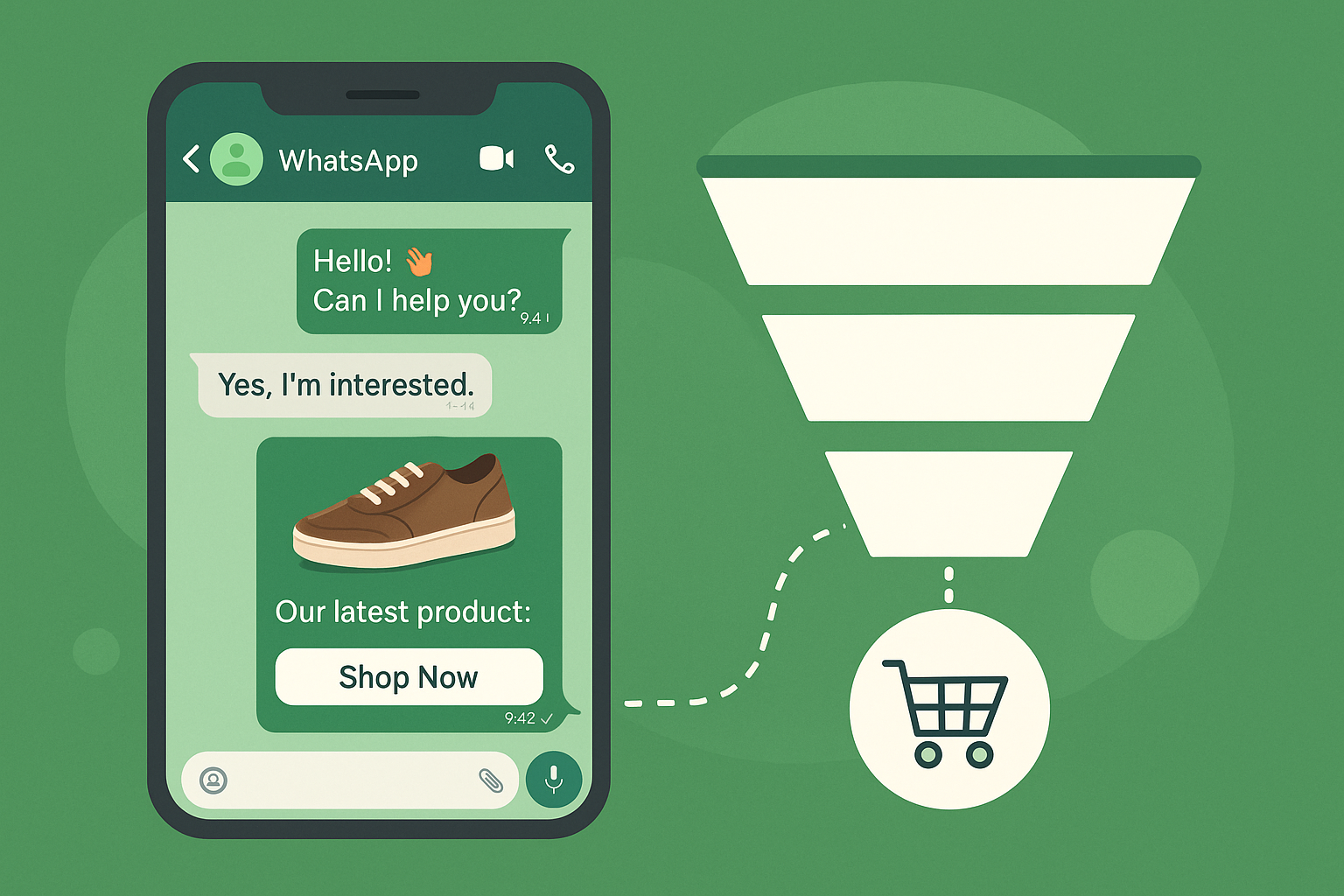
Introduction In 2025, WhatsApp is no longer just a messaging app—it’s becoming a powerful commerce engine. For D2C brands, the real magic lies in turning chats into conversions. Imagine a potential customer clicks “Chat with us,” immediately engages in conversation, and completes the purchase—all without ever leaving WhatsApp. That’s the essence of a well-built WhatsApp marketing funnel. In this blog, we’ll walk you through how D2C brands can structure, optimize, and scale a WhatsApp funnel—from discovery to retention. We’ll cover strategies, tools, real‑world tips, and pitfalls to avoid. 1. Why WhatsApp Funnels Are Ideal for D2C Brands 2. The WhatsApp Funnel Stages (Chat → Checkout Pathway) Here’s a breakdown of key funnel stages in WhatsApp marketing for D2C brands: Stage Purpose Key Tactics 1. Entry / Discovery Get people to initiate chat Click‑to‑WhatsApp ads, website CTA, QR codes, “Chat now” buttons 2. Qualification & Engagement Understand user needs, segment them Automated flows, quick replies, menus, prompting questions 3. Product Showcase & Offer Present product(s) & value Catalogs, carousels, images + brief descriptions, personalized offers 4. Checkout & Payment Facilitate the actual purchase In‑chat payment links, UPI, card integrations, redirecting strategically 5. Post‑Purchase & Retention Nurture for loyalty & repeat Order updates, feedback, cross-sell, drip flows, reactivation nudges Let’s go deeper into each. 2.1 Entry / Discovery 2.2 Qualification & Engagement Once a user messages, an automated flow or chatbot should: This step helps you segment the user (e.g. new vs returning, product interest) and provide tailored messaging downstream. 2.3 Product Showcase & Offer Because the user is already engaged, they’re more likely to act on offers within the same flow. 2.4 Checkout & Payment This is the pivotal moment: The goal: minimize friction and avoid forcing the user to leave the chat unless absolutely necessary. 2.5 Post-Purchase & Retention Even after conversion, the funnel continues: This helps convert one-time buyers into repeat customers. 3. Common Mistakes & How to Avoid Them Conclusion WhatsApp funnels are redefining how D2C brands convert and retain customers. The advantage? You meet your audience where they already are—chat—and carry them gently toward purchase, all within a single app. To build your funnel: If you blend smart tech, human touch, and data-driven iteration, you’ll convert more chats into checkouts—and build loyalty along the way. FAQs Q: What is a WhatsApp marketing funnel for D2C brands? A: It’s a structured chat-based path—from first message to purchase—designed to engage, convert, and retain customers within WhatsApp. Q: Can a D2C brand sell directly in WhatsApp? A: Yes, using the WhatsApp Business API + catalog/payment integrations, brands can let users browse and pay without leaving chat. Q: What tools should D2C brands use for WhatsApp funnels? A: Choose a BSP (e.g., AiSensy, Kommunicate, Zoko) that supports automation, CRM integration, templates, analytics, and fallback options. Q: How often can you message customers on WhatsApp? A: Be cautious. Stick to 1–2 promotional sends per week unless they re-engage. Use templated messages and respect WhatsApp’s 24‑hour window rules. Q: How do you measure ROI in WhatsApp funnels? A: Track metrics like delivery rate, open rate, click-through rate, conversion rate, opt‑outs, and cost per conversion. Compare revenue generated vs messaging and tool costs.
Turning First‑Time Buyers Into Lifetime Fans: D2C Edition

Introduction In today’s D2C landscape, acquiring a customer is just the beginning. The real challenge—and opportunity—lies in converting that one-time buyer into a lifelong fan who not only returns but also advocates for your brand. For D2C brands, this shift from transaction to relationship is essential to achieving long-term growth, reducing acquisition costs, and building community-driven brand equity. 1. Deliver an Exceptional Post‑Purchase Experience The buyer journey doesn’t end at checkout—it starts a new phase. 2. Personalize Every Interaction Customers expect relevance. Data helps make that happen. 3. Build a Loyalty Program That Feels Valuable Loyalty should go beyond points. Make it meaningful. 4. Create a Community, Not Just a Customer List Communities build brand love—and trust. 5. Support That Goes Beyond Solving Problems Customer service should feel like customer care. 6. Re-Engage Lapsed Customers Proactively Retention doesn’t mean passive waiting—it means smart reactivation. 7. Measure & Optimize for Loyalty Track the right metrics to stay ahead. Case Snapshot: D2C in Action A home fitness D2C brand launched an onboarding email series post-purchase, invited customers to a private fitness community, and offered rewards for workout video submissions. The result? Conclusion D2C brands must prioritize retention as much as acquisition. Turning a first-time buyer into a lifetime fan means creating a journey filled with personalization, care, community, and continuous value. When you treat customers like people—not transactions—they return the favor with loyalty. FAQs Q1: What is the most important step to retain first-time D2C buyers? A: The post-purchase experience. It sets the tone for your brand relationship—make it exceptional, personalized, and supportive. Q2: How can small D2C brands afford to create loyalty programs? A: Start simple—offer discounts on second purchases or early access to sales. Use low-cost tools and scale as you grow. Q3: How do I know if my customers are becoming loyal fans? A: Track repeat purchase rates, referral activity, customer reviews, and engagement metrics like email opens and community participation. Q4: Is community really necessary for all D2C brands? A: While not mandatory, community adds significant brand equity. Even small efforts like private social groups or shared hashtags can increase retention and advocacy. Q5: What if a customer has a bad first experience? A: Address it immediately with proactive support, make it right, and offer a personal gesture of goodwill. You can often turn a poor experience into a loyalty opportunity.
Latest WhatsApp Business Statistics That Matter in 2025

Introduction: In 2025, WhatsApp Business isn’t just a messaging tool—it’s the backbone of customer engagement for millions of brands worldwide. With over 2.8 billion global users and business adoption surging across industries, WhatsApp remains the most effective way for D2C, eCommerce, and SMBs to connect with customers. This blog brings you the latest WhatsApp Business statistics for 2025, highlighting trends that matter and showing how The BotMode helps brands turn these numbers into growth. WhatsApp User Statistics 2025 Insight for Brands: If your business isn’t on WhatsApp in 2025, you’re missing the single most engaged audience in digital marketing. WhatsApp Business App Adoption The BotMode Advantage: By integrating Shopify, WooCommerce, and CRM, brands can move beyond the basic app to scalable API-based automation. WhatsApp Commerce & Revenue Stats The BotMode Insight: D2C brands using WhatsApp Broadcast, abandoned cart recovery, and upsell campaigns see 15–30% revenue uplift within 60 days. WhatsApp Broadcast & Campaign Stats AI & Automation in WhatsApp (2025 Trend) The BotMode Edge: With AI-powered WhatsApp automation, brands personalize conversations at scale—like recommending products based on purchase history. Regional WhatsApp Business Adoption Why These Statistics Matter for Your Business FAQs Q1. How many businesses use WhatsApp in 2025? Over 200 million businesses globally use WhatsApp Business, with adoption highest in India, Brazil, and Southeast Asia. Q2. Is WhatsApp better than SMS or email for campaigns? Yes. WhatsApp has higher open (98%) and response rates, interactive features, and personal delivery that SMS/email can’t match. Q3. What’s the role of AI in WhatsApp Business in 2025? AI powers chatbots, smart scheduling, and personalized campaigns—boosting efficiency and conversions. Platforms like The BotMode lead this shift. Conclusion The latest statistics prove one thing: WhatsApp Business is no longer optional—it’s essential. With billions of users, unmatched engagement, and proven commerce success, brands that master WhatsApp in 2025 will stay ahead. And with The BotMode, you get automation, personalization, compliance, and analytics—all in one growth platform. Ready to leverage WhatsApp in 2025? Book your free demo with The BotMode and turn these stats into real business growth













